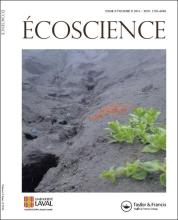Resource information
Agricultural development on floodplains contributes to hydrologic alteration and forest fragmentation, which may alter landscape-level processes. These changes may be related to shifts in the seed bank composition of floodplain wetlands. We examined the patterns of seed bank composition across a floodplain watershed by looking at the number of seeds germinating per m² by species in 60 farmed and intact forested wetlands along the Cache River watershed in Illinois. The seed bank composition was compared above and below a water diversion (position), which artificially subdivides the watershed. Position of these wetlands represented the most variability of Axis 1 in a Nonmetric Multidimensional Scaling (NMS) analysis of site environmental variables and their relationship to seed bank composition (coefficient of determination for Axis 1: r² == 0.376; Pearson correlation of position to Axis 1: r == 0.223). The 3 primary axes were also represented by other site environmental variables, including farming status (farmed or unfarmed), distance from the mouth of the river, latitude, and longitude. Spatial analysis based on Mantel correlograms showed that both water-dispersed and wind/water-dispersed seed assemblages had strong spatial structure in the upper Cache (above the water diversion), but the spatial structure of water-dispersed seed assemblage was diminished in the lower Cache (below the water diversion), which lost floodpulsing. Bearing analysis also suggested that water-dispersal process had a stronger influence on the overall spatial pattern of seed assemblage in the upper Cache, while wind/water-dispersal process had a stronger influence in the lower Cache. An analysis of the landscapes along the river showed that the midââlower Cache (below the water diversion) had undergone greater land cover changes associated with agriculture than did the upper Cache watershed. Thus, the combination of forest fragmentation and hydrologic changes in the surrounding landscape may have had an influence on the seed bank composition and spatial distribution of the seed banks of the Cache River watershed. Our study suggests that the spatial pattern of seed bank composition may be influenced by landscape-level factors and processes.Nomenclature: USDA, 2005.



